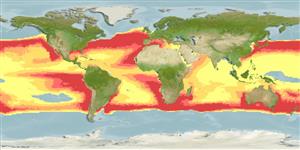Elasmobranchii (sharks and rays) >
Lamniformes (Mackerel sharks) >
Lamnidae (Mackerel sharks or white shark)
Etymology: Carcharodon: Greek, karcharos = sharpen + Greek, odous = teeth (Ref. 45335); carcharias: From the Greek 'karcharios' which refers to man-eater sharks (Ref. 6885).
Environment / Climate / Range
Ecology
Marine; brackish; pelagic-oceanic; oceanodromous (Ref. 51243); depth range 0 - 1200 m (Ref. 106604), usually 0 - 250 m (Ref. 55270). Subtropical, preferred 25°C (Ref. 107945); 66°N - 58°S, 180°W - 180°E
Cosmopolitan, mostly amphitemperate. Western Atlantic: Newfoundland, Canada to Argentina; also north Gulf of Mexico, Bahamas, Cuba and Lesser Antilles (Ref. 26938). Eastern Atlantic: France to South Africa, including the Mediterranean. Indian Ocean: Seychelles, South Africa; also Reunion and Mauritius (Ref. 33390). Western Pacific: Siberia to New Zealand and the Marshall Islands; also south Australia (Ref. 26938). Central Pacific: Hawaii. Eastern Pacific: Alaska to Chile. International trade cooperation, Australia (CITES Appendix III, since 28.5.2003; CMS Appendix I and II).
Length at first maturity / Size / Weight / Age
Maturity: Lm ?, range 450 - 500 cm
Max length : 541 cm TL male/unsexed; (Ref. 10635); 594.0 cm TL (female); max. published weight: 0.00 g; max. reported age: 36 years (Ref. 31395)
Dorsal
spines
(total): 0;
Dorsal
soft rays
(total): 0;
Anal
spines: 0;
Anal
soft rays: 0. A huge, spindle-shaped shark with conspicuous black eyes, a blunt, conical snout and large, triangular, saw-edged teeth (Ref. 5578). First dorsal-fin origin usually over the pectoral-fin inner margins (Ref. 43278, 6871). Caudal fin crescentic (Ref. 247). Lead-grey to brown or black above, lighter on sides, and abruptly white below (Ref. 6851). Black spot at rear pectoral fin base (Ref. 6851).
Primarily a coastal and offshore inhabitant of continental and insular shelves, but may also occur off oceanic islands far from land (Ref. 247, 43278, 58302). Often close inshore to the surf line and even penetrates shallow bays (Ref. 247). Maximum depth of 700 fathoms (or 1280 m) reported by Bigelow & Schroeder, 1948 is erroneous (Francis et al., 2012 in Ref. 106604). Pelagic, capable of migration across oceanic regions (Ref. 58302). Usually solitary or in pairs but can be found in feeding aggregations of 10 or more; does not form schools (Ref. 247). Feeds on bony fishes, sharks, rays, seals, dolphins and porpoises, sea birds, carrion, squid, octopi and crabs (Ref. 5578) and whales (Ref. 32140). Ovoviviparous, embryos feeding on yolk sac and other ova produced by the mother (Ref. 43278, 50449). Number of young born per litter, 7 (Ref. 31395) to 14 (Ref. 26346). Reported by some experts to attack humans which they mistake for their normal prey (Ref. 47). Most attacks occur in estuaries. Caught by big-game anglers and line boats for its jaws (Ref. 5578). Reported to cause poisoning (Ref. 4690). Flesh is utilized fresh, dried-salted, and smoked for human consumption, the skin for leather, liver for oil, carcass for fishmeal, fins for shark-fin soup, and teeth and jaws for decorations (Ref. 13574). Maximum total length is leading to much speculation and some measurements are found to be doubtful. Possibly to 6.4 m or more in length (Ref. 43278), considered the world's largest predator with a broad prey spectrum. The record of 10.98 m is incorrect (Ref. 13574). Maximum total length for male from Ref. 91029. Sometimes considered the most dangerous shark in the world (Ref. 26938).
Exhibit ovoviparity (aplacental viviparity), with embryos feeding on other ova produced by the mother (oophagy) after the yolk sac is absorbed (Ref. 50449). Up to 10, possibly 14 young born at 120-150 cm (Ref. 26346). Distinct pairing with embrace (Ref. 205). Male and female may swim in parallel while copulating (Ref. 28042, 49562).
Compagno, L.J.V., 1984. FAO Species Catalogue. Vol. 4. Sharks of the world. An annotated and illustrated catalogue of shark species known to date. Part 1 - Hexanchiformes to Lamniformes. FAO Fish. Synop. 125(4/1):1-249. Rome, FAO. (Ref. 247)
IUCN Red List Status (Ref. 115185)
Human uses
Fisheries: minor commercial; gamefish: yes
Tools
Special reports
Download XML
Internet sources
